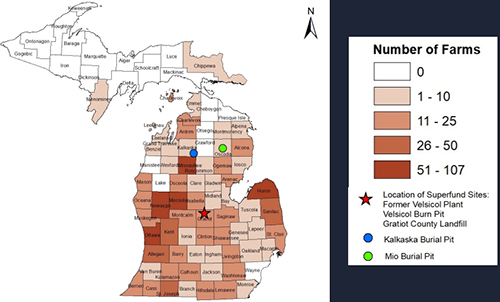
Welcome to the Michigan PBB Registry Research Portal
In the 1970s, an industrial accident at the Michigan Chemical facility (owned by Velsicol), in St. Louis, Michigan, led to a flame retardant, FireMaster, being mistakenly shipped as an animal nutritional supplement. The main chemical in FireMaster was an endocrine-disrupting chemical, polybrominated biphenyl (PBB). Livestock feed containing PBB was widely distributed, and millions of Michigan residents consumed contaminated farm products during the nearly full year it took to uncover the error. Hundreds of farms were quarantined, and millions of farm animals were destroyed. In addition to the widespread contamination of the food supply, individuals who worked at the chemical plant, farmers who handled the contaminated feed, and their household contacts were exposed through inhalation, ingestion, and dermal absorption. The St. Louis community was left with three superfund sites and contamination of the adjacent Pine River. Today, PBB is still detectable in the blood of those who were exposed in the 1970s. With support from NIH and CDC, The Michigan state health department set up a registry to study the acute and chronic effects of PBB among people exposed. In the 2000s, Emory University officially took over the registry research as the lead scientific organization.

The Michigan PBB Registry team is a collaborative effort between scientists at Emory University and several community organizations including the Pine River Superfund Citizen Task Force, the PBB Citizens Advisory Board, and the Mid-Michigan District Health Department. We aim to conduct research that meets the needs of the community. We have set up this portal to facilitate access to the PBB Registry data and biospecimens for researchers to serve the needs of those exposed and to advance our knowledge of the impacts of PBB and similar chemicals on human health and the environment.
Data have been collected through various questionnaires administered over the years to the entire cohort and to specific subgroups for specific studies over the years. The table below shows the name of each study/questionnaire and the time period when administered. A box indicates data were collected during this period. For specifics about what was included in each questionnaire, see Table 4, Data Dictionary.
- To filter by Study period, please click on the time frame and click either Keep Only or Exclude.
- To reset your selections and the table, please click the |← button below the table.
Biospecimens accompanied by additional data have been collected from cohort members at various times and among specific subgroups of the cohort. Below is a table detailing the research sub-cohorts and the data available for each sub-cohort.
- To filter by Method, Data Elements, or Study, please click on the item and click either Keep Only or Exclude.
- To reset your selections and the table, please click the |← button below the table.
Try our Scientific Documentation page for our shared data/analysis articles.